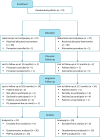Laparoscopic sacrocolpopexy versus abdominal sacrocolpopexy for vaginal vault prolapse: long-term follow-up of a randomized controlled trial
- PMID: 36112182
- PMCID: PMC9483545
- DOI: 10.1007/s00192-022-05350-y
Laparoscopic sacrocolpopexy versus abdominal sacrocolpopexy for vaginal vault prolapse: long-term follow-up of a randomized controlled trial
Abstract
Introduction and hypothesis: The objective of this study was to evaluate long-term outcomes of laparoscopic sacrocolpopexy (LSC) versus abdominal sacrocolpopexy (ASC) for vaginal vault prolapse (VVP).
Methods: Long-term follow-up of a multicenter randomized controlled trial (SALTO trial). A total of 74 women were randomly assigned to LSC (n=37) or ASC (n=37). Primary outcome was disease-specific quality of life, measured with validated questionnaires. Secondary outcomes included anatomical outcome, composite outcome of success, complications, and retreatment.
Results: We analyzed 22 patients in the LSC group and 19 patients in the ASC group for long-term follow-up, with a median follow-up of 109 months (9.1 years). Disease-specific quality of life did not differ after long-term follow-up with median scores of 0.0 (LSC: IQR 0-17; ASC: IQR 0-0) on the "genital prolapse" domain of the Urogenital Distress Inventory in both groups (p = 0.175). Anatomical outcomes were the same for both groups on all points of the POP-Q. The composite outcome of success for the apical compartment is 78.6% (n = 11) in the LSC group and 84.6% (n = 11) in the ASC group (p = 0.686). Mesh exposures occurred in 2 patients (12.5%) in the LSC group and 1 patient (7.7%) in the ASC group. There were 5 surgical reinterventions in both groups (LSC: 22.7%; ASC: 26.3%, p = 0.729).
Conclusions: At long-term follow-up no substantial differences in quality of life, anatomical results, complications, or reinterventions between LSC and ASC were observed. Therefore, the laparoscopic approach is preferable, considering the short-term advantages.
Trial registration: Dutch Trial Register NTR6330, 18 January 2017, https://www.trialregister.nl/trial/5964.
Keywords: Abdominal sacrocolpopexy; Laparoscopic sacrocolpopexy; Mesh exposure; Post-hysterectomy prolapse; Vaginal vault prolapse.
© 2022. The Author(s).
Conflict of interest statement
None.
Figures
References
-
- Marchionni M, Bracco GL, Checcucci V, Carabaneanu A, Coccia EM, Mecacci F, et al. True incidence of vaginal vault prolapse. Thirteen years of experience. J Reprod Med. 1999;44(8):679–684. - PubMed
Publication types
MeSH terms
LinkOut - more resources
Full Text Sources
Medical
Miscellaneous



